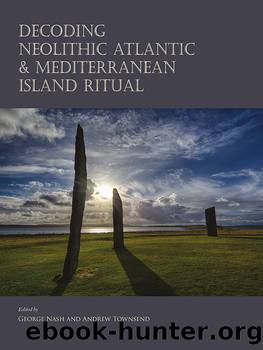Decoding Neolithic Atlantic and Mediterranean Island Ritual by Nash George; Townsend Andrew;

Author:Nash, George; Townsend, Andrew;
Language: eng
Format: epub
Tags: Bisac Code 1: SOC003000
ISBN: 4456615
Publisher: Oxbow Books, Limited
Published: 2016-05-14T16:00:00+00:00
Figure 9.1 The Adriatic, showing the location of GrapÄeva Cave and other sites mentioned in the text. Black: caves; white: open air sites
The setting
The Mediterranean region boasts several island groups which in prehistoric times comprised hubs of social, economic, and cultural activity. Of these, the eastern Adriaticâs islands form the Mediterraneanâs second largest archipelago, with more than 1100 islands of varying size and configuration, following some 1200 km of coastline. Arranged in several rows roughly parallel to the coast, the islands are distributed across an area that is some 400 km in length (from Dubrovnik in the south-east to Pula in the north-west) and between 20 and 50 km in width (Fig. 9.1).
The Adriatic archipelago was formed in the relatively recent past. Before the present interglacial period, virtually all todayâs islands were part of the mainland, with only a few exceptions. After 12,000 BC, the rising sea-level produced by the Earthâs melting icecap began to flood what were then the Dinaric Mountainsâ coastal valleys, and by 6000 BC the majority of the islands had more-or-less attained their current configuration (van Andel 1989; 1990; Forenbaher 2008a).
The islandsâ natural resources vary, but generally they are resource-poor, with little arable soil or fresh water available. As with the mainland, the islandsâ landscapes are karstic, which means that agriculture requires a major investment of intensive labour to clear rocks from fields and to create terraces and cisterns â activities that go back at least to the Bronze Age (Chapman et al. 1996). Extensive tracts of stony land, and sometimes entire islands, are extraordinarily difficult to farm and are more productively exploited by turning to animal husbandry. Only a very few islands have relatively large expanses of land that can be farmed. Given the limits of traditional subsistence economies and technologies, a number of the larger islands could, however, have supported permanent populations subsisting on a mixture of agriculture, herding and fishing.
Although the archaeological evidence is variable, it appears that all the large islands were settled early in the Neolithic. Finds from LoÅ¡inj (KomÅ¡o et al. 2004), Dugi Otok (BrusiÄ 2004), BraÄ (Miracle 1995), Hvar (Kaiser & Forenbaher n.d.; Forenbaher 2008a), and KorÄula (ÄeÄuk & RadiÄ 2005), indicate that they were inhabited by humans before the Holocene transgression separated them from the mainland. Most, if not all, appear to have been occupied continuously from Neolithic times to the present (Benac 1979â1987). This is not surprising given their proximity to the mainland or to the neighbouring islands. In prehistoric times, each one of those islands potentially supported up to a few thousand inhabitants (StanÄiÄ & Gaffney 1996; Forenbaher 2002).
Many of the smaller islands and islets have also yielded archaeological evidence of prehistoric human activity. While most may have been too small to sustain, unaided, a human population, they were usually only a short distance from a larger island or the mainland, which enabled âcommutingâ islanders to exploit external resources (Bass 1998). One way or another, Adriatic island communities were essentially self-sufficient. This does not mean, however, they were totally isolated.
Download
This site does not store any files on its server. We only index and link to content provided by other sites. Please contact the content providers to delete copyright contents if any and email us, we'll remove relevant links or contents immediately.
| Anthropology | Archaeology |
| Philosophy | Politics & Government |
| Social Sciences | Sociology |
| Women's Studies |
Mysteries by Colin Wilson(2885)
People of the Earth: An Introduction to World Prehistory by Dr. Brian Fagan & Nadia Durrani(2346)
Ancient Worlds by Michael Scott(2102)
Foreign Devils on the Silk Road: The Search for the Lost Treasures of Central Asia by Peter Hopkirk(2056)
The Memory Code by Lynne Kelly(1945)
Lost Technologies of Ancient Egypt by Christopher Dunn(1797)
The Splendid and the Vile by Erik Larson(1781)
Come, Tell Me How You Live by Mallowan Agatha Christie(1768)
The Earth Chronicles Handbook by Zecharia Sitchin(1744)
The Plantagenets by Dan Jones(1615)
Last Chance to See by Douglas Adams(1599)
The Return of the Gods by Erich von Daniken(1572)
Wars of the Anunnaki by Chris H. Hardy(1392)
Before the Dawn by Nicholas Wade(1315)
Keeper of Genesis by Graham Hancock(1280)
The Cygnus Mystery by Andrew Collins(1258)
The Message of the Sphinx by Graham Hancock(1223)
Fragile Lives by Stephen Westaby(1116)
Hieroglyphs: A Very Short Introduction by Penelope Wilson(1034)
